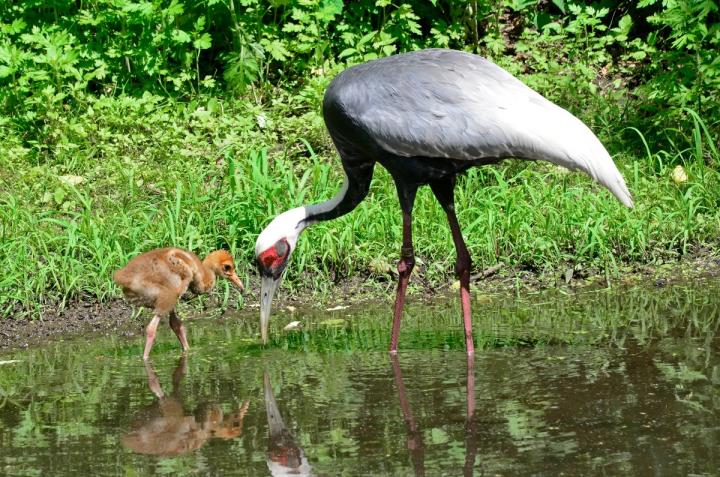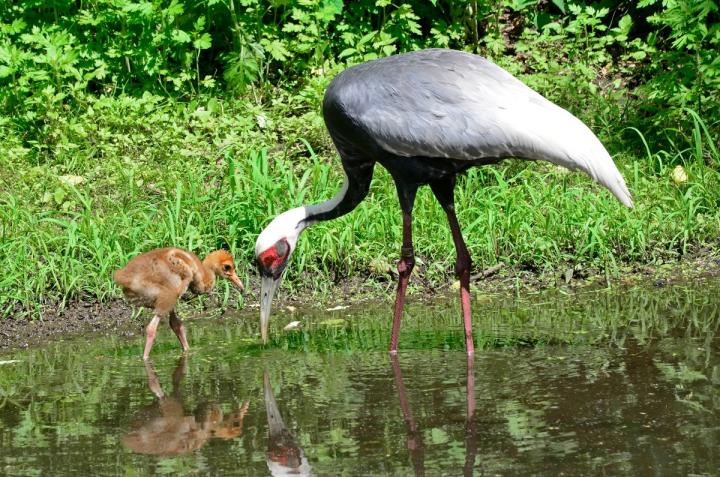
Ulaanbataar, Mongolia (July 7, 2016) – A new study by WCS (Wildlife Conservation Society) says that breeding populations of white-naped cranes have decreased by 60 percent in Ulz River basin – an important stronghold for the species in Eastern Mongolia.
Survey data from 2000-2001 recorded 42 territorial pairs while the most recent data by WCS documented only 17 pairs.
Eastern Mongolia supports one of the world's most important breeding populations of the white-naped crane, a species classified by the IUCN as "vulnerable," with an estimated total population at 5,500-6,500 individuals. Among the threats to the birds are habitat loss and fire.
Between 2010-2011, WCS visited a 270-kilometer (167-mile) section of the Ulz River basin where (Bradter et al, 2005) surveyed in 2000 and 2001. Additionally, during the same period, WCS extended the survey to more historic crane breeding sites with locations provided by from the Mongolian Academy of Sciences. Those sites are Kherlen River, Onon River catchment and the Khurkh Khuiten Ramsar site.
"Wetland ecosystems across the steppe grasslands of Eastern Mongolia represent critically important breeding habitat for white-naped cranes," said Martin Gilbert, WCS Wildlife Veterinarian. "By revisiting areas surveyed by other researchers ten years earlier, we were able to assess how numbers had changed during a decade of severe drought."
Despite standing over 4 feet tall, the researchers found that the cranes were surprisingly difficult to observe, even in the open habitat of the Mongolian steppe. After observing 234 cranes, the scientists used occupancy modelling to estimate 867-1017 cranes inhabit the survey area, suggesting that Mongolia supports almost half of the world's breeding white-naped cranes.
In the ten years between surveys, using spatial modeling, the scientists noted that an extended drought affected Eastern Mongolia's wetland systems. Additionally, models performed by the scientists indicated that the birds prefer areas of tall wet vegetation and low grazing pressure (to allow for nesting). Several lakes and whole stretches of river that supported cranes in 2001 were completely dry by the 2010 survey, and unsuitable for breeding cranes.
Gilbert said, "Although white-naped cranes may be one of the most visible inhabitants of Mongolia's wetland communities, their habitat is critical for a whole suite of highly threatened flora and fauna. The declining numbers of cranes is alarming, and may signal wider problems, affecting many more species."The study findings, combined with declines noted in wintering counts in China, "do strongly suggest that global white-naped crane populations may indeed be in decline."
Said WCS Mongolia Country Program Director Enkhtuvshin Shiilegdamba: "These shrinking habitats represent a lifeline for nomadic herding communities and their livestock. Management of remaining water resources will become increasingly important as climate change progresses. Management decisions must be made with engagement of local stakeholders and be well informed by sound science if we are to meet the needs of both the cranes and local people in the decades ahead. Some of the wetland habitats are well managed and protected by herder communities who have been an active part of the WCS project work. This practice needs to be extended to other communities that share the landscape with cranes."
###
"Declining breeding populations of White-naped Cranes in Eastern Mongolia, a ten-year Update," appears online in Bird Conservation International. Authors include: Martin Gilbert, Bayarbaatar Buuveibaar, Amanda E. Fine, Losolmaa Jambal, and Samantha Strindberg.
Funding for this project was provided by the National Institute of Allergy and Infectious Disease, National Institutes of Health, Department of Health and Human Services (Contract No. HHSN2662007 00009C); the United States Agency for International Development (USAID) Scaling up Conservation Success with Sustainable Conservation Approaches in Priority Ecosystems Cooperative Agreement (No. EEM-A-00-09-0007-00); and the Wildlife Conservation Society
WCS (Wildlife Conservation Society)
MISSION: WCS saves wildlife and wild places worldwide through science, conservation action, education, and inspiring people to value nature. To achieve our mission, WCS, based at the Bronx Zoo, harnesses the power of its Global Conservation Program in nearly 60 nations and in all the world's oceans and its five wildlife parks in New York City, visited by 4 million people annually. WCS combines its expertise in the field, zoos, and aquarium to achieve its conservation mission. Visit: newsroom.wcs.org Follow: @WCSNewsroom. For more information: 347-840-1242.
Media Contact
Stephen Sautner
[email protected]
718-220-3682
@TheWCS
http://www.wcs.org





